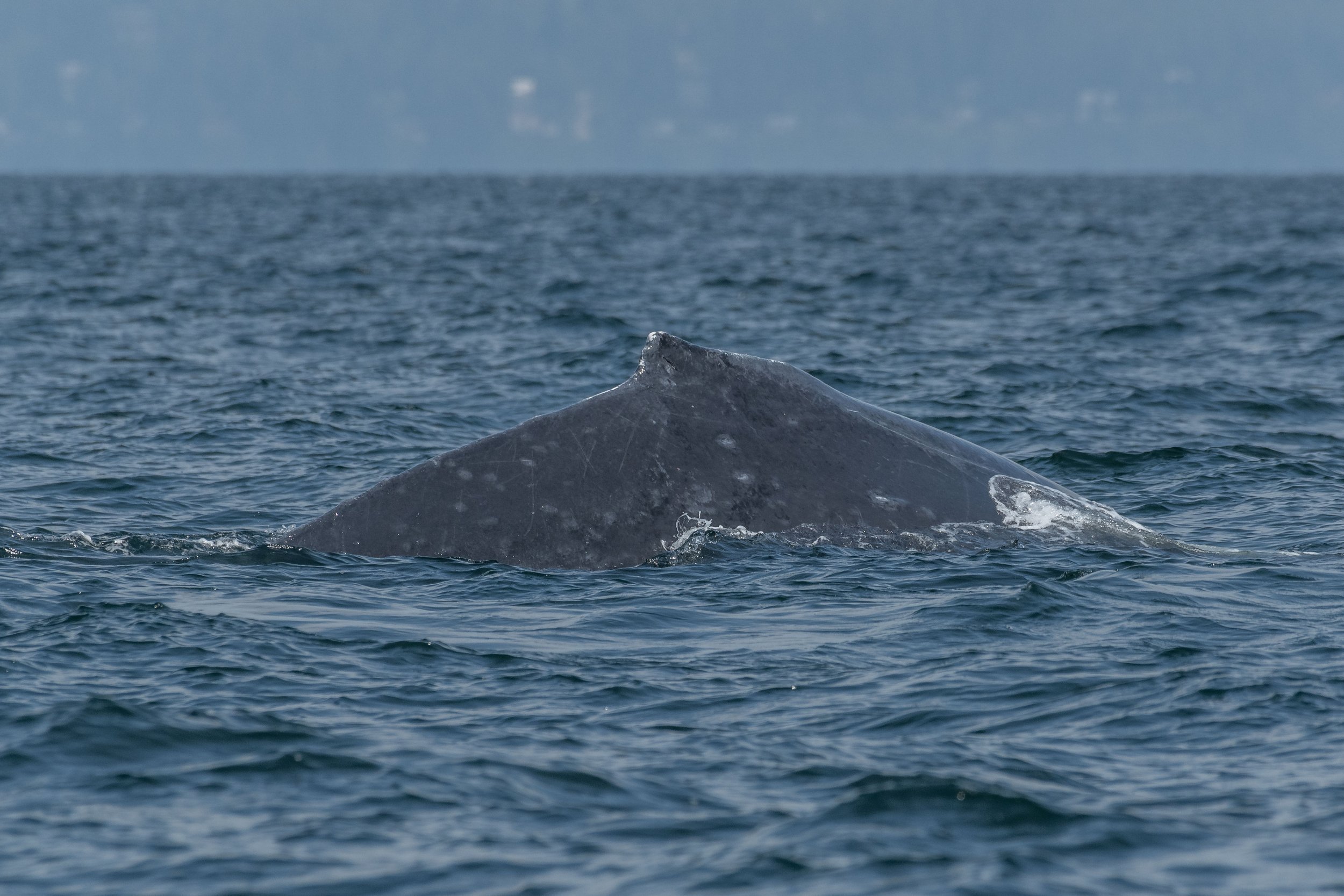July 22, 2024, 10:30 AM - Orca and Humpbacks a stones throw away from each other.
Today was a great day to be out on the water, with light winds and sunny skies. We hopped onto our three vessels and began scanning for whales. The light winds made it perfect to venture out into the Strait of Georgia across to Halibut Bank. The geology in this spot is perfect for creating an area of high productivity, due to an underwater hill which allows an upwelling of oxygen and nutrients. It is fairly common to spot a blow or two near here, and today was no different.
We were very lucky to get a double species day today, and getting to see both our humpbacks and orca in one tour is always a treat! A common question we often get is “Do the Orca attack the Humpbacks?”. More often than not, the two species ignore each other when we spot them in the same areas. However, they have been known to harass each other, and often try to actively avoid each other. However, orcas are also the only known predators of the Humpback whale, and will also attack and eat other species, like minke and porpoises. While not as common in our waters, killer whales offshore in the Pacific may hunt young humpbacks, and calves are especially vulnerable to predation. Here in the Salish Sea, there are lots of other food sources, such as harbour seals and sea lions, so the need to hunt a humpback is much less. However, that doesn’t stop the orca from bullying the humpbacks, sometimes chasing them directly. But the humpbacks fight back, using their size to make it a fair fight! Sometimes we see them chasing the orca right back, or other big behaviours like breaching, tail slapping or pec slapping to scare off the pod.
A lot of the large whales are built for speed, like the streamlined Minke or Fin whale, but not the Humpback! While large in size, these gentle giants are not nearly as quick as the orca, travelling at around 25km/hr at their maximum speed. The pectoral fin of the humpback is around 16 feet long with barnacles that attach themselves to them, so a slap from these long fins can do some serious damage! The humpback also has size and weight on the orca and they have been documented charging at the orca and throwing that weight around. Yes, the orca are indeed the apex predators on the Salish Sea but the humpbacks are no pushovers!
The Humpbacks we encountered today were Graze (BCY0523) and Crater (BCX1565), and we can assume they were finding food. We saw some tail lobbing, some cartwheeling and a bit of napping as well! Just like us humans, these two probably had a big meal, fell asleep, and then woke up and burned off some of that energy. We got to see these two slapping at each other, with Crater tail slapping towards Graze for most of the encounter. Definitely some communication going on there!
Once we spent some time with our tail lobbing humpbacks, we headed towards the Sunshine Coast, where we got a hot tip that there might be orca in the region. We were lucky enough to find our little group just south of Gibsons. Today, our Orca seemed like they were on a mission, travelling south when we spotted them, most likely patrolling for a meal. A common denominator between our whales is they are usually searching for something to snack on! The travelling pods we spotted today were:
T086A3 Tyndall ♀ (2011)
T086A3A (2024)
T124A2 Elkugu ♀ (2001)
T124A2A Agafia ♂ (2013)
T124A2B Litton ♀ (2016)
But wait there’s more! On the way home, one of our vessels spotted two more blows in the area, so they decided to take a quick peek and see who it was. It was another pair of humpbacks, probably with the same idea as the rest of the whales we spotted today… mealtime on the mind! This pair was Fader (BCY0195) and Incognito (BCX2053). After getting an identification on these two we continued on to meet some of our cutest members in the Salish Sea, our Harbour Seals. They were resting on the rocks, sunning themselves. They spend their time warming up on the rocks after spending time in our chilly waters hunting their prey! We then returned to the dock with big grins on our faces, and it is always amazing to see both our giants in one go!
Photos taken by Marine Naturalists Aly Kohlman, Cheyenne Brewster and Desarae Poier.
Graze surfacing. Photo by Aly Kohlman.
Crater’s dorsal fin. Photo by Aly Kohlman.
Fader’s dorsal fin. Photo by Aly Kohlman.
Incognito’s dorsal fin. Photo by Aly Kohlman.
Can you spot the tubercles on the top jaw? Photo by Aly Kohlman.
A good look at the blow hole. Photo by Aly Kohlman.
Humpback poop! Photo by Aly Kohlman.
Fader showing off that tail! Photo by Aly Kohlman.
A fluke from Graze. Photo by Des Poier.
Having a tail slapping good time! Photo by Cheyenne Brewster.
A big splash! Photo by Des Poier.
Crater tail lobbing. Photo by Des Poier.
Photo by Des Poier.
Photo by Des Poier.
Crater seemed to have a lot of calories to burn. Photo by Des Poier.
T124A2 Elkugu. Photo by Aly Kohlman.
Making a splash! Photo by Aly Kohlman.
T086A3A following their mother T086A3 Tyndall. Photo by Aly Kohlman.
Look at that eye! Photo by Aly Kohlman.
How many orca can you see? Photo by Cheyenne Brewster.
T124A2B Litton following T124A2 Elkugu. Photo by Des Poier.
T124A2B Litton. Photo by Des Poier.
T086A3A following T086A3 Tyndall. Photo by Des Poier.
T086A3A. Photo by Des Poier.
Cormorants in the sun. Photo by Des Poier.
A chubby Harbour Seal. Photo by Des Poier.
Very chubby Harbour seals! Photo by Des Poier.
A proud mother Harbour seal and her pup. Photo by Des Poier.




























